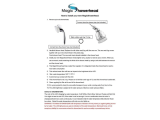
3
Guarantee
For domestic installations, Mira Showers
guarantee the products listed in this guide against
any defect in materials or workmanship for a
period of three years from the date of purchase
(shower ttings for one year).
For non-domestic installations, Mira Showers
guarantee the products listed in this guide against
any defect in materials or workmanship for a
period of one year from the date of purchase.
For terms and conditions refer to the back cover
of this guide.
Recommended Usage
Application
Valve with
Fittings
Domestic
ü
Light Commercial
ü
Heavy Commercial
û
Healthcare
û
Patents and Design Registration
Patents:
GB: 2 291 693, 2 340 210, 2 392 225,
2 421 297
Euro: 1 672 257 DE, FR, GB, IT, NL, SE
USA: 7 240 850
Patent Applications:
Euro: 03254070.0
USA: 2006-0124758-A1, 2007-0221740-A1
Design Registration:
000793401-0005-00011
SAFETY WARNINGS
Mira thermostatic mixers are precision engineered
and should give continued safe and controlled
performance, provided:
1. They are installed, commissioned, operated and
maintained in accordance with manufacturer’s
recommendations.
2. Type 2 Valves are only used for applications
covered by their approved designations, refer
to the TMV2 Requirements Manual.
3. Periodic attention is given, when necessary,
to maintain the product in good functional
order.
Caution!
1. Read all of these instructions.
2. Retain this guide for later use.
3. Pass on this guide in the event of change of
ownership of the installation site.
4. Follow all warnings, cautions and instructions
contained in this guide.
5. Anyone who may have difculty understanding
or operating the controls of any shower should
be attended whilst showering. Particular
consideration should be given to the young,
the elderly, the inrm or anyone inexperienced
in the correct operation of the controls.
6. Rapid/Excessive movement of the ow and/
or temperature control levers may result in
momentary unstable blend temperatures.
7. Care is required when adjusting flow or
temperature, make sure that the temperature
has stabilised.
8. When this product has reached the end of its
serviceable life, it should be disposed of in a
safe manner, in accordance with current local
authority recycling, or waste disposal policy.





















